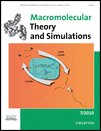Phase-Field Simulation of Long-Wavelength Line Edge Roughness in Diblock Copolymer Resists†
Official contribution of the National Institute of Standards and Technology; not subject to copyright in the United States of America.
Abstract
We examine stochastic computer simulations of the Leibler-Ohta-Kawasaki (LOK) phase-field model1, 2 and demonstrate that long-wavelength line edge roughness (LER) and line width roughness (LWR) in a lamellar diblock copolymer resist depend monotonically on quench depth and noise strength, and that the LER and LWR spectra both exhibit a peak at k0–the characteristic wavenumber of mesophase separation in diblock copolymers. For k ⪅ k0, we find that the LER spectrum approximately scales like k−1.6. These observations are consistent with previous theoretical, computational, and experimental examinations LER and LWR in diblock copolymer melts, and thus the LOK phase-field model should be considered a capable and appropriate framework for future examination of long-wavelength LER and LWR in block copolymer resist systems.





